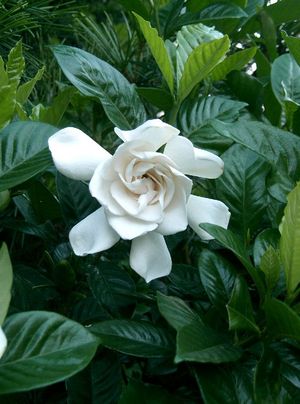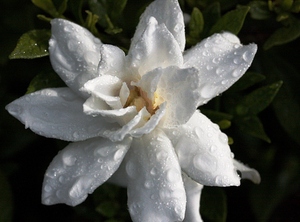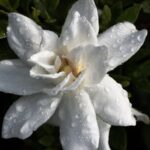Normally I try to write about houseplants that are easy to grow and easy-care to encourage more people to give gardening a try. Gardenias, however, are not that easy to grow and are definitely high-maintenance. Nevertheless, if you have become more confident in your gardening skills and/or would like to take on a challenge, including a gardenia in your houseplant collection is really worth the effort.
There are several varieties of gardenias; however, the cape jasmine (Gardenia jasminoides) is the one most commonly grown as a houseplant. This particular variety is an evergreen that grows to be 1-2 feet indoors. It has thick, glossy, dark-green leaves common to most gardenias. The blooms are about 3 inches across, double with a waxy feel, and a glorious white color. Of course, the main reason for growing gardenias is the fragrance; and the cape jasmine gardenia will not disappoint.
Now comes the hard part; i.e., encouraging your gardenia to thrive and bloom. The cape jasmine gardenia needs light, the right temperature, high humidity, proper soil conditions, and proper watering. (Do not give up at this point. All of these conditions can be met.) First, plant your gardenia in a soilless mix. (It is really easier to make your own using 2 parts sphagnum peat moss, 1 part perlite, and 1 part vermiculite. This mixture makes the medium more acidic — which gardenias love — and holds moisture better — another thing that gardenias love. You can also use equal parts all-purpose potting mix and peat moss. Another choice would be to find potting mixes specifically for acid-loving plants, which will probably be available at your local gardening center.) Fertilize once a month with a fertilizer made specifically for acid-loving plants. (A fertilizer for azaleas will work.) In addition, if you notice that new growth is turning yellow, there is a good chance that your gardenia is suffering from iron chlorosis, caused by soil that is too alkaline. Treat with iron sulfate. If you discover that the water in your area is too alkaline, then you should give your gardenia some iron chelate every 2-3 months. (Once again, check with your local gardening center for both of this iron supplements.)
Gardenias need at least 4 hours of direct light each day, and bud drop will occur if the plant is not getting enough light. [See Houseplants: Determining the Light Levels in Your House.] I recommend that you invest in a grow-light, which can be found at most home improvement stores. Grow-lights are especially beneficial in the winter months when light is at a premium. (You can put your gardenia outdoors in the spring if you want.)
Gardenias also need humidity and will start dropping flower buds if the humidity is too low. [You should refer to Houseplants: Increasing the Humidity.] Be sure to place your gardenia on a humidity tray, and you might even want to invest in a humidifier, especially for the winter months when the air is drier in the home. In addition, mist the plant frequently.
Proper watering of gardenias is essential. Too little, and buds will drop. Too much, and buds will drop. Keep the soil evenly moist at all times, and do not allow your gardenia to dry out. You also do not want it to be soggy. [See Watering Houseplants: Identifying Problems.]
As if all of the above conditions were not enough, gardenias are also sensitive to the temperature in the room in which you decide to place them. They do like a warm room without any drafts. (Drafts can cause bud drop.) When you want your gardenia to bloom, however, do not allow the temperature of the room to go over 62 degrees Fahrenheit. (It only takes one warm night for your gardenia to refuse to bloom.) For gardenias that you want to bloom in the winter, pinch off any buds until late September. This will ensure that you will have blooms about mid-winter.
All of this sounds like a lot of work. (And it is.) Nevertheless, when the fragrance of gardenias begins to waif through your house, you will be so glad that you took the time and put forth the effort.
References:
DeWolf, Jr., Gordon P., ed. Taylor’s Guide to Houseplants. Boston, MA: Houghton Mifflin, 1987.
Horan, Anne, and Robert G. Mason. Flowering Houseplants. Alexandria, VA: Time-Life Books, 1990.



